FAMACHA is a simple but useful tool for farmers to check if their sheep, goats, or cattle have a serious worm problem, especially from the barber’s pole worm (Haemonchus contortus).
This worm is dangerous because it sucks blood from the stomach, leading to blood loss (anemia). This makes animals weak, and if not treated, they can die.
The FAMACHA method works by checking the color of the inside of the animal’s eyelid.
Contents
Understanding the FAMACHA Score

The FAMACHA scoring system ranks eyelid color on a scale from 1 to 5, corresponding to the level of anemia in the animal.
A special color-reference card is used to compare the inner lower eyelid (conjunctiva) to these standardized color categories.
Each score has a specific meaning in terms of the animal’s health and parasite load:
1. Score 1 (Red)
Eye membrane is deep red, indicating the animal is not anemic and has a healthy red blood cell count. This is a good sign, usually meaning little to no barber’s pole worm burden.
2. Score 2 (Red-Pink)
Eye is red-pink, indicating a mild level of anemia. The animal has a slight parasite load but is generally still in acceptable condition.
3. Score 3 (Pink)
Eye is medium pink, indicating moderate anemia. This is a borderline zone; the animal has a significant worm burden and careful consideration is needed (see below on when to treat).
4. Score 4 (Pink-White)
Eye is pale pink to pink-white, indicating severe anemia. The animal has a heavy parasite infection (often a high Haemonchus load) and is in poor condition.
5. Score 5 (White)
Eye membrane is white or almost white, indicating very severe anemia. This animal is dangerously infested with blood-sucking worms and at risk of death if not treated immediately
In short, the darker red the eyelid, the healthier the animal’s blood status; the paler the eyelid, the more anemic and worm-burdened the animal is.
This anemia is usually due to the barber’s pole worm drinking the animal’s blood, so FAMACHA scores correlate with the likely parasite load. It’s important to note that only whole numbers are used, no “half scores.” If an eyelid color falls between two categories, you should round up to the higher (worse) score to be safe
Interpreting FAMACHA Scores
Scores 1 and 2Scores 1 and 2 (Healthy/Minor Anemia)
These animals have red or pink-red eyelids and do not need deworming. Keep checking them at the regular interval.
If they show other parasite signs like diarrhea or bottle jaw, investigate further.
Score 3Score 3 (Moderate Anemia – Borderline Case)
Deworm if:
- More than 10% of the herd has scores of 4 or 5.
- The animal is young, pregnant, or lactating.
- The animal is weak or in poor condition.
- If the animal is healthy and in good condition, you can monitor and recheck in a week before deciding.
Scores 4 and 5Scores 4 and 5 (Severe/Very Severe Anemia)
These animals have pale or white eyelids and need immediate deworming. A score 5 is an emergency and requires urgent treatment. Provide supportive care like high-quality feed and reduce stress. Check again in 7 to 10 days to ensure recovery.
Why Farmers Should Use it
Using the FAMACHA system offers several benefits for herd health and farm management:
Targeted Deworming
FAMACHA enables selective treatment, meaning you only deworm the animals that truly need it. Typically, a minority of the herd carries the majority of the worm burden (often ~20% of animals harbor 80% of the worms). By identifying these high-risk individuals (scores 3, 4, 5) and treating them, you avoid giving dewormer to all animals unnecessarily.
This saves time and money, and it’s more efficient.
For example, instead of drenching 100% of the flock, you might treat only 20–30% that need it.
Reducing Drug Resistance
Targeted deworming helps slow down the development of parasite resistance to dewormers. When you treat only some animals, some worms remain unexposed to the drug (a concept called refugia), which preserves a population of worms that are still susceptible to treatments. Over time, this practice extends the effective life of dewormer medications on your farm.
Improved Animal Health
By catching anemia early, FAMACHA scoring allows you to treat animals before they reach a crisis. Regular checks mean heavily infested animals get prompt deworming, which prevents fatalities and reduces performance losses (such as poor weight gain or milk production) from parasites. Healthier animals will be more productive and suffer less from parasitic disease.
Cost Savings
You use less dewormer overall because you’re not routinely treating animals that don’t need it.
Also, by maintaining efficacy of drugs longer (due to slower resistance development), you won’t have to switch to more expensive or less effective dewormers as frequently.
Selective Breeding and Culling
FAMACHA records help identify which animals are consistently parasite-resistant or -susceptible.
For example, ewes/does that always score 1–2 (healthy pink eyelids) even in peak parasite season are showing parasite resilience, whereas those repeatedly scoring 4–5 are highly susceptible.
Farmers can use this information to select breeding stock that are more worm-resistant and cull chronically susceptible animals.
Over time, this improves the herd’s genetic resistance to parasites, meaning fewer problems and treatments in future generations.
Monitoring Dewormer Effectiveness
FAMACHA can indirectly indicate if your dewormers are working.
After treating an anemic animal, its eyelid color should improve (score drop from say 4 to 2) within about a week.
If many treated animals remain pale or their scores worsen after deworming, it may signal drug resistance in the worm population. In such cases, you might perform a fecal egg count reduction test or consult a vet to confirm if the dewormer failed.
This feedback helps you make informed decisions about which dewormers to use.
How to Perform the FAMACHA Test
1.
Safely hold or restrain your sheep, goat, or calf to keep it still.
This could mean having a helper hold the animal, using a halter, or securing the animal in a small pen or cattle chute. Good restraint keeps the animal (and you) safe and ensures you can get a clear look at the eye.
2.
Using your non-dominant hand, cover the animal’s eye by gently rolling the upper eyelid down over the eyeball.
This step makes the animal think it’s dark and causes the third eyelid to retract. It also helps position the eye for the next step. (Imagine you are closing the animal’s eye by pushing the top lid down.)
3.
While still covering the eye, use your thumb (or index finger) to apply gentle pressure on the eyeball through the upper lid.
Press the eye inward slightly into the socket.
A good indicator that you’re doing this right is that the eyelashes of the upper lid will start to curl up over your thumb. This pressure isn’t painful. It just causes the membranes of the lower lid to protrude a bit.
4.
With the eye still pressed in, use your other hand (usually the dominant hand) to pull down the lower eyelid.
The lower lid will move down, and the pink inner tissue (conjunctiva) will come into view. This is the membrane whose color we need to judge.
5.
When you pull the lower lid, the inner mucous membrane will “pop” into view, bulging out a bit.
You should now see the bed of pink (or pale) tissue clearly. Make sure you are looking at the inner conjunctival membrane, not the inside of the outer skin of the eyelid. (The conjunctiva is the moist layer that actually reflects anemia; the inside of the lid or the third eyelid may be paler and shouldn’t be scored).
6.
Immediately hold the FAMACHA color chart next to the exposed eyelid and compare the color of the animal’s membrane to the color blocks on the card.
Do this in good light (preferably natural daylight). Decide which color category (1 through 5) the eye color matches best.
Be quick and make your decision in a second or two based on the color you see.
The reason to be quick is that prolonged forcing of the eyelid can cause the blood to flush in or out and alter the color; a prompt comparison gives the most accurate reading
7.
Determine the FAMACHA score (1, 2, 3, 4 or 5) corresponding to the card color that closest matches the eyelid.
Do not use half-scores or in-betweens. If it’s between two shades, err on the side of caution and choose the higher number (more anemic). For example: if you think it’s between a 2 and 3, record it as 3. This ensures you won’t overlook an animal that might be getting into trouble.
8.
It’s recommended to repeat the process on the other eye as well.
Most of the time the scores will be the same, but occasionally one eye can appear slightly paler (for instance, if there was a local issue or injury).
Use the worse (higher) score of the two eyes as the animal’s FAMACHA score. Checking both eyes adds confidence that you didn’t miss anything.
9.
Write down the animal’s ID and its score (and the date) immediately, especially if you have many animals to go through.
This helps in decision-making (who to treat now) and for keeping long-term health records (see Record Keeping section).
10.
Gently let the animal’s eyelid return to normal and release the animal from restraint. The whole eye-check process for one animal takes only a few seconds once you are practiced.
Important technique tips: Always use the official FAMACHA card for comparison every time. Do not rely on memory or guess the colors. The human eye can be unreliable and the card ensures consistency. Also, do not try to shortcut the method by just pulling down the lower eyelid without covering and pushing first.
Below is a video from the University of Rhode Island (see refs.) that shows you how to do the test.
What Equipment is Needed
One of the appeals of FAMACHA is that it requires very minimal equipment.
Here’s what a farmer should have on hand to use the FAMACHA system effectively:
1. FAMACHA Card
A special laminated card with five color shades (scores 1–5) used to check anemia.
Use only official cards (not printed copies) to ensure accurate colors. Get one through training or veterinary services. Store in a dark place to prevent fading and replace it every few years.
2. Good Lighting
Natural daylight is best (morning or late afternoon). If indoors, use bright natural light from a window. Avoid dim barns, deep shade, or artificial lights.
3. Animal Restraint
Use pens, chutes, halters, or assistants to keep animals still. For cattle, use a head gate or squeeze chute. Handle animals gently to minimize stress.
4. Clean Hands/Gloves
Wash hands before checking the eye to avoid infection. Gloves (latex or nitrile) can be used for hygiene and protection but are not required. Keep fingernails short to prevent injury.
5. Record Keeping
Use a notebook, chart, or mobile app to log FAMACHA scores with animal ID and date. Keep records handy for tracking herd health.
6. Additional Aids
If needed, use reading glasses for better vision. A cap with a brim helps reduce glare. Some farmers carry the FAMACHA card on a lanyard for quick access.
FAMACHA Limitations
- Works only for Barber’s Pole Worm. It detects anemia caused by Haemonchus contortus, not other parasites like brown stomach worms or coccidiosis.
- Anemia has other causes. Pale eyelids can also result from liver flukes, lice, nutrition issues, or diseases, not just worms.
- Less reliable in cattle. Cows show anemia differently, making FAMACHA less accurate for them.
- Labor-intensive. Checking each animal regularly takes time and effort, especially in large herds.
- Needs training. Color perception can vary, so proper training ensures accurate scoring.
- Card must be maintained. Keep it stored properly to prevent fading and replace it every few years
- Not a complete solution. FAMACHA only identifies anemia. It does not prevent or treat worms. Combine it with good parasite control practices.
- May miss sudden cases. Animals can decline fast between checks, so frequent monitoring is needed.


